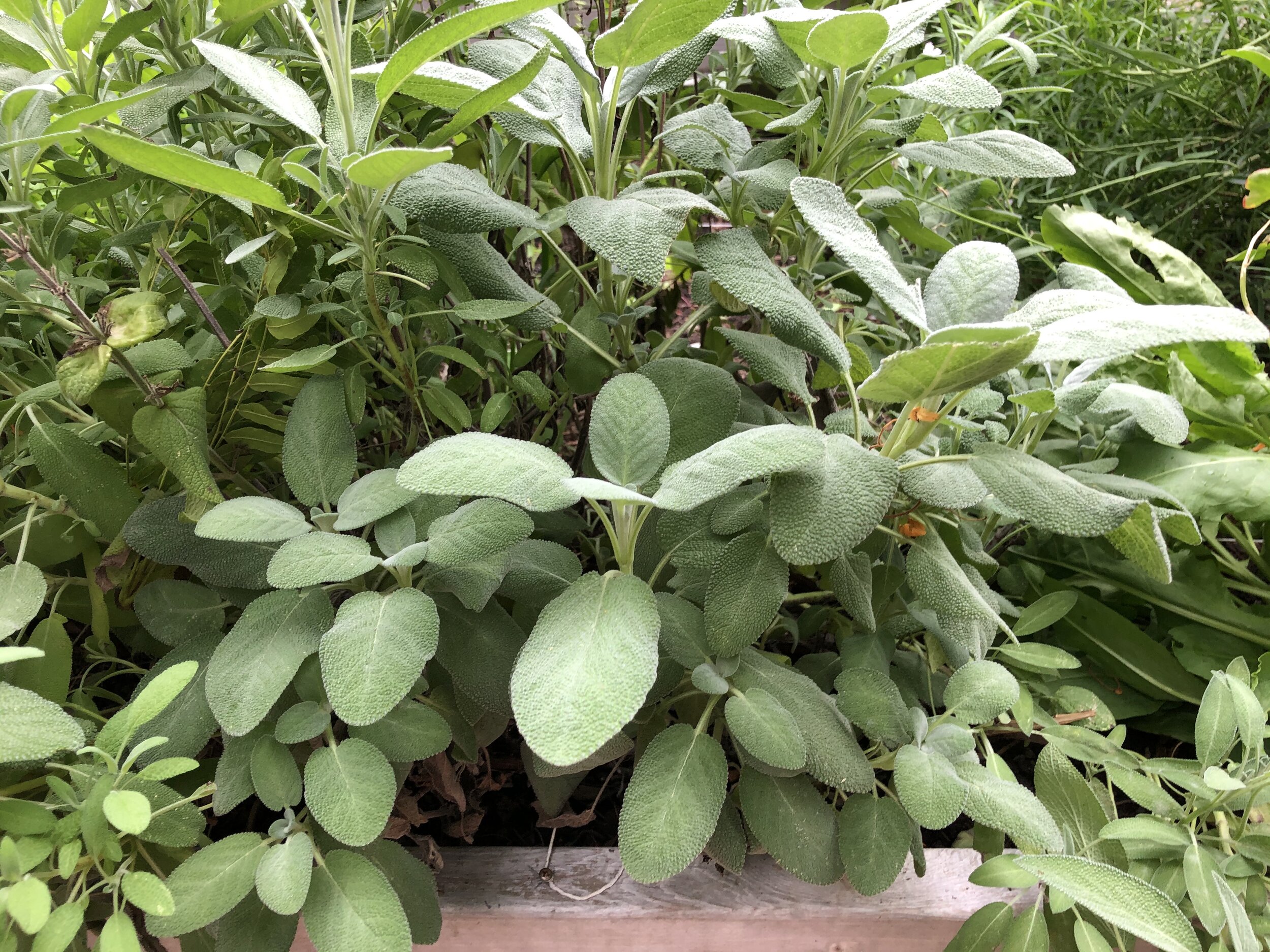by Jiling Lin
Botanical Name: Salvia spp.
Family: Lamiaceae
Parts Used: leaves, flowers
Energetics: warming, drying
Taste: pungent, aromatic
Properties: antiseptic, carminative, diaphoretic, nervine, digestive, expectorant, anti-inflammatory
Preparations: tea, tincture, oil infusion, steam, honey, glycerite, capsule, vinegar
Salvia Introduction
Salvia spathacea (hummingbird sage)
I reach out to pet various aromatic sages as I walk up and down our southern California trails, where we are blessed with an abundance of sages, or plants of the genus Salvia. The most commonly seen Salvia species among our myriad local natives in my Ventura County backyard include Salvia apiana (white sage), S. mellifera (black sage), S. leucophylla (purple sage), and S. spathacea (hummingbird sage).
White sage is commonly seen in new agey stores, bundled into smudge sticks. I frequently add both black and white sage into bean dishes. Purple sage has delicate violet flowers on a large bushy plant, whereas hummingbird sage has big boisterous pink blooms that grow up to hip height growing in individual clusters. Our sages are diverse and plentiful, with soft leaves and strong scents. Given their bioregional prevalence, ease of growing, and plethora of uses, I commonly employ Salvia spp. both personally and clinically.
Salvia Botany
Sages are in the genus Salvia. They are mint family members, the Lamiaceae. Like other mint family plants, they have square stems, alternating opposite leaves, irregular ball-like flower clusters, and a pungent aromatic smell. Some distinguishing Salvia features include furry ovate leaves with lightly toothed margins, often sticky. Their leaves and flowers vary in size and color.
Cultivation
Sages enjoy full to partial sunlight, in well-draining soil. Plant the seeds in the fall, then watch them grow in the spring. Sages are easy to germinate and grow, but not frost tolerant. They can also be grown from cuttings. White sage, Salvia apiana, is overharvested. Grow it easily at home, instead of wildcrafting!
Wildcrafting and Processing Salvia spp.
Harvest leaves and flowers in the summer, and throughout the growing season. These hardy plants grow back easily. Wash lightly if soiled, then dry either bundled upside down for small collections, or strewn across a large tarp or cloth for larger collections. If processing seeds, then collect in the autumn. Cut seed heads into a paper bag.
Medicinal Preparations + Uses
Sages are antibiotic, expectorant, diaphoretic, and anti-inflammatory. They move stagnation, such as digestive, respiratory, and even emotional stagnation. Sages’ bright aroma can uplift sunken spirits and move cloudy thoughts. Sages are often added to meat dishes to help prevent or alleviate flatulence, constipation, bellyaches, and other digestive stagnation. Sages can help alleviate sore throat associated with the common cold, with its antibiotic and diaphoretic properties.
Sages are miscible in a variety of menstrua, meaning that they easily extract their phyto-constituents into diverse media, such as water, oil, alcohol, sugars, and even salt.
Tea: Add fresh or dried leaves/ flowers to hot water. Let steep 5-10 minutes. Use both topically and internally.
- A simple respiratory aid tea: sage, ginger, honey
- To alleviate sinus congestion with a sore throat, carefully inhale the steam. Heat water, add dried or fresh leaves to create a strong tea, turn off the stove, then stand over your steaming sage infusion with a towel over your head for 5 minutes.
Tincture: Chop fresh fresh leaves and flowers for a 1:2 alcohol extraction with 95% alcohol. With dried leaves, make a 1:5 alcohol extraction with 50% alcohol.
Culinary/Other Uses
Oil: Infuse chopped freshly dried or dried sage leaves in oil or vinegar for delicious salad dressings or other culinary uses. The infused oil also applies well as a massage oil for light circulatory stimulation and stress reduction. Here’s some simple sage-infused oil formulas that I enjoy:
- First aid ointment: sage, plantain, lavender
- Anointing oil/ salve: S. apiana, Artemisia spp., Pinus spp.
- Chocolate: sage-infused chocolate with rose petals and cracked salt on top
Salvia officinalis (culinary sage)
Honey: Chop freshly dried or dried sage leaves and flowers into honey. I particularly love colorful sages that add colors, aroma, and flavors to honeys for both culinary and medicinal benefits. Add honey infusions from stronger sages, such as S. apiana, to cough or respiratory formulas.
Salt: Finely chop fresh sage leaves, then mix with sea salt. Let sit for two weeks covered in a dry cool place, mixing daily. Season your dishes with sage-infused salt for a subtle sage flavor.
Bath: many possibilities for a relaxing yet invigorating sage bath:
- massage yourself with sage-infused oil before settling into a warm bath
- rub sage-infused oil into epsom salts then pour into a warm bath
- add a pot of sage tea to the end of your bath, reserving a cup to sip
Incense: Sages are ritualistically burned across various cultures for cleansing and purifying. Its pungent aroma is said to lift and carry prayers to their desired recipients. Bundle fresh sage leaves into smudge bundles then let dry. Or, dry the leaves first, then crunch or powderize into more complex incenses.
Want more herbal goodness?
🌼Sign up for the HerbRally newsletter and receive these THIRTEEN herbal freebies!
VIDEO | Most Vital Herb in David Hoffmann’s First-Aid Kit
WEBINAR | Herbal First Aid with Heather Irvine
EBOOK | 86 Page Plant Healer Book
30 DAYS FREE | HerbRally Schoolhouse
EBOOK | Calendula for Radiant Skin by Rosalee de la Forêt
VIDEO | 5 Herbal Events Around the World presented by Bevin Clare
BOOK DISCOUNT | The Essential Guide to Western Botanical Medicine
PRIVATE COMMUNITY | HerbRally Facebook Group
BOOK EXCERPT | 36 Pages from Plant Healer's "Nourishing Foods" Book
DISCOUNT | 15% off all Mountain Rose Herbs products
DISCOUNT | Mushroom Revival
AUDIO | Hour-long Adaptogens Class with Heather Irvine
DISCOUNT | 10% off all HerbRally products
👉 CLAIM YOUR FREEBIES!
Jiling Lin, LAc is an acupuncturist, herbalist, and yoga teacher in Ventura, CA. She empowers community resilience through clinics, classes, and retreats. Jiling cultivates thriving health through nature connection, patient education, and accessible healthcare. She specializes in treating pain, trauma, and complex chronic conditions. Visit Jiling at JilingLin.com , Instagram, and Facebook.
References
- Baldwin, Goldman, Keil, Patterson, Rosatti, Wilken, The Jepson Manual (California: University of California Press, 2012) 834- 860.
- Thomas Easley and Steven Horne, The Modern Herbal Dispensatory (California: North Atlantic Books, 2016), 298.
- Thomas Elpel, Botany in a Day (Montana: Hops Press, 2013), 157- 159.
- Michael Moore, Medicinal Plants of the Mountain West (New Mexico: Museum of New Mexico Press, 2003), 225- 228.




